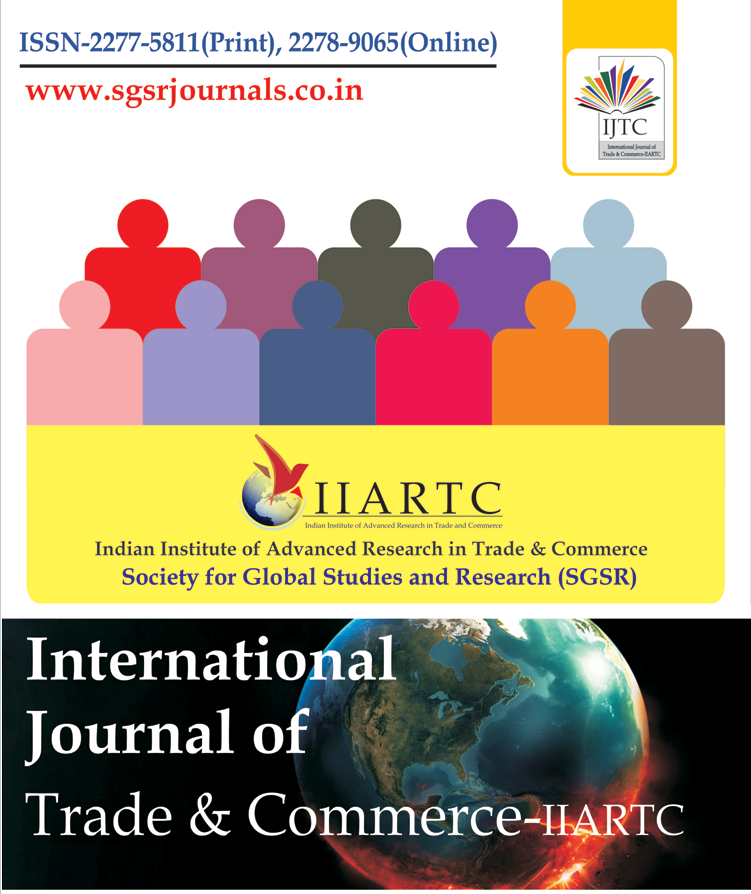Home ⇨ International Journal of Trade & Commerce-IIARTC

International Journal of Trade & Commerce-IIARTC
Impact Factor (IF):5.135 (COSMOS), IF:7.249 (ISRA), IF:3.721 (ISI)
ISSN:2277-5811 (P), ISSN:2278-9065 (O)
Frequency: Half Yearly
A Study of Relationship between Education Infrastructure and Economic Growth in Madhya Pradesh
The role of education in facilitating social and economic progress is well recognized. It opens up opportunities leading to both individual and group entitlements. Education, in its broadest sense of development of youth, is the most crucial input for empowering people with skills and knowledge and giving them access to productive employment in future. Improvements in education are not only expected to enhance efficiency but also augment the overall quality of life. Thus it seems the State is striving more and more for expanding higher education in Madhya Pradesh, however, the very foundation of higher learning, the primary education is still one of the major challenges for the government. The state still demonstrates slow pace in terms of performance on four basic variables used in computing Educational Development Index [EDI] at the primary level. But inspite of only 4247 new government primary schools has been opened in 2008-09. And share of government schools to total school is increased by 0.20 percent only. Until and unless, the easy access, basic infrastructure & availability of quality teachers is not pledged at the primary level, the goal of universalization of education would remain a distant dream. Infrastructural misery of Madhya Pradesh is also depicted in the level of electricity connection in schools which demonstrate that only 10.74% primary and overall 20.56% schools are having electricity connections. Still there are large numbers of schools that are located in interior areas and are devoid of electricity. For a long time, poor performance on the basic schooling front was attributed to a lack of schools and teachers on the supply side, and poverty, parental attitudes, social barriers and prevalent social customs on the demand side. As noted earlier, significant progress has been made on both fronts. Recent research indicates that an important factor explaining both the high drop-out rates and also the persistence of out-of-school children is the stark fact that many of our schools are unattractive - physically and pedagogically. Giving adequate attention to the software of education and issues of quality is a must.
Author:Surya Prakash Tripathia*, Mansi Kukrejab, Neeru Joshic
Abstract:The role of education in facilitating social and economic progress is well recognized. It opens up opportunities leading to both individual and group entitlements. Education, in its broadest sense of development of youth, is the most crucial input for empowering people with skills and knowledge and giving them access to productive employment in future. Improvements in education are not only expected to enhance efficiency but also augment the overall quality of life. Thus it seems the State is striving more and more for expanding higher education in Madhya Pradesh, however, the very foundation of higher learning, the primary education is still one of the major challenges for the government. The state still demonstrates slow pace in terms of performance on four basic variables used in computing Educational Development Index [EDI] at the primary level. But inspite of only 4247 new government primary schools has been opened in 2008-09. And share of government schools to total school is increased by 0.20 percent only. Until and unless, the easy access, basic infrastructure & availability of quality teachers is not pledged at the primary level, the goal of universalization of education would remain a distant dream. Infrastructural misery of Madhya Pradesh is also depicted in the level of electricity connection in schools which demonstrate that only 10.74% primary and overall 20.56% schools are having electricity connections. Still there are large numbers of schools that are located in interior areas and are devoid of electricity. For a long time, poor performance on the basic schooling front was attributed to a lack of schools and teachers on the supply side, and poverty, parental attitudes, social barriers and prevalent social customs on the demand side. As noted earlier, significant progress has been made on both fronts. Recent research indicates that an important factor explaining both the high drop-out rates and also the persistence of out-of-school children is the stark fact that many of our schools are unattractive - physically and pedagogically. Giving adequate attention to the software of education and issues of quality is a must.




